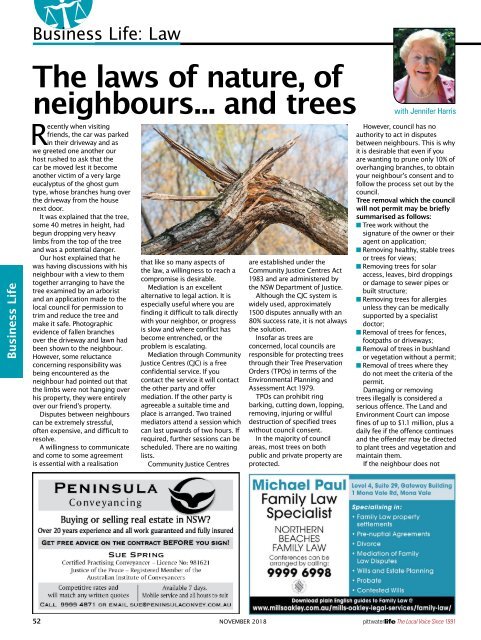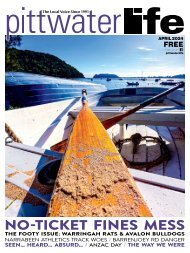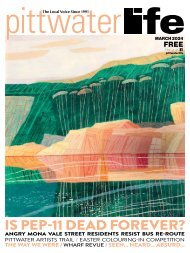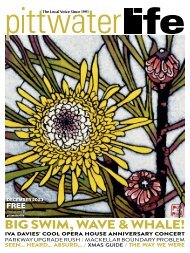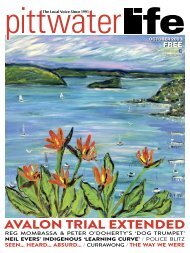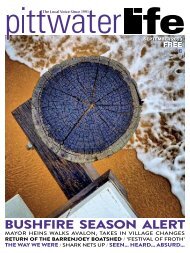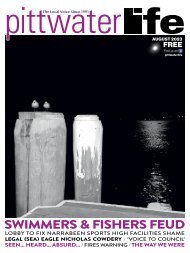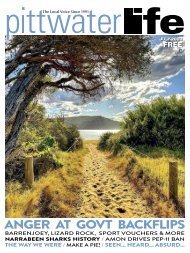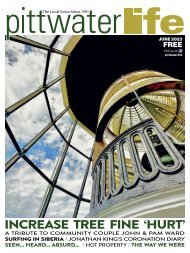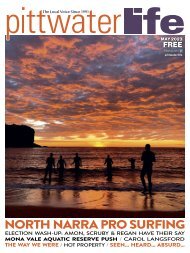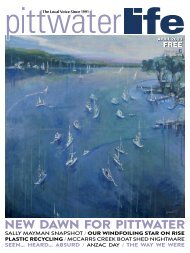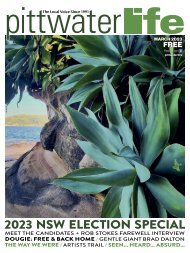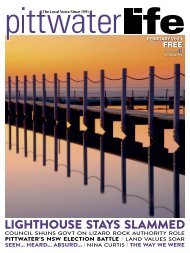Pittwater Life November 2018 Issue
Coming to Your Rescue. Missing 'Link'. Offleash Dog Trial. Wonders of Science. Market Month!
Coming to Your Rescue. Missing 'Link'. Offleash Dog Trial. Wonders of Science. Market Month!
Create successful ePaper yourself
Turn your PDF publications into a flip-book with our unique Google optimized e-Paper software.
Business <strong>Life</strong>: Law<br />
Business <strong>Life</strong><br />
The laws of nature, of<br />
neighbours... and trees<br />
Recently when visiting<br />
friends, the car was parked<br />
in their driveway and as<br />
we greeted one another our<br />
host rushed to ask that the<br />
car be moved lest it become<br />
another victim of a very large<br />
eucalyptus of the ghost gum<br />
type, whose branches hung over<br />
the driveway from the house<br />
next door.<br />
It was explained that the tree,<br />
some 40 metres in height, had<br />
begun dropping very heavy<br />
limbs from the top of the tree<br />
and was a potential danger.<br />
Our host explained that he<br />
was having discussions with his<br />
neighbour with a view to them<br />
together arranging to have the<br />
tree examined by an arborist<br />
and an application made to the<br />
local council for permission to<br />
trim and reduce the tree and<br />
make it safe. Photographic<br />
evidence of fallen branches<br />
over the driveway and lawn had<br />
been shown to the neighbour.<br />
However, some reluctance<br />
concerning responsibility was<br />
being encountered as the<br />
neighbour had pointed out that<br />
the limbs were not hanging over<br />
his property, they were entirely<br />
over our friend’s property.<br />
Disputes between neighbours<br />
can be extremely stressful,<br />
often expensive, and difficult to<br />
resolve.<br />
A willingness to communicate<br />
and come to some agreement<br />
is essential with a realisation<br />
that like so many aspects of<br />
the law, a willingness to reach a<br />
compromise is desirable.<br />
Mediation is an excellent<br />
alternative to legal action. It is<br />
especially useful where you are<br />
finding it difficult to talk directly<br />
with your neighbor, or progress<br />
is slow and where conflict has<br />
become entrenched, or the<br />
problem is escalating.<br />
Mediation through Community<br />
Justice Centres (CJC) is a free<br />
confidential service. If you<br />
contact the service it will contact<br />
the other party and offer<br />
mediation. If the other party is<br />
agreeable a suitable time and<br />
place is arranged. Two trained<br />
mediators attend a session which<br />
can last upwards of two hours. If<br />
required, further sessions can be<br />
scheduled. There are no waiting<br />
lists.<br />
Community Justice Centres<br />
are established under the<br />
Community Justice Centres Act<br />
1983 and are administered by<br />
the NSW Department of Justice.<br />
Although the CJC system is<br />
widely used, approximately<br />
1500 disputes annually with an<br />
80% success rate, it is not always<br />
the solution.<br />
Insofar as trees are<br />
concerned, local councils are<br />
responsible for protecting trees<br />
through their Tree Preservation<br />
Orders (TPOs) in terms of the<br />
Environmental Planning and<br />
Assessment Act 1979.<br />
TPOs can prohibit ring<br />
barking, cutting down, lopping,<br />
removing, injuring or willful<br />
destruction of specified trees<br />
without council consent.<br />
In the majority of council<br />
areas, most trees on both<br />
public and private property are<br />
protected.<br />
with Jennifer Harris<br />
However, council has no<br />
authority to act in disputes<br />
between neighbours. This is why<br />
it is desirable that even if you<br />
are wanting to prune only 10% of<br />
overhanging branches, to obtain<br />
your neighbour’s consent and to<br />
follow the process set out by the<br />
council.<br />
Tree removal which the council<br />
will not permit may be briefly<br />
summarised as follows:<br />
n Tree work without the<br />
signature of the owner or their<br />
agent on application;<br />
n Removing healthy, stable trees<br />
or trees for views;<br />
n Removing trees for solar<br />
access, leaves, bird droppings<br />
or damage to sewer pipes or<br />
built structure;<br />
n Removing trees for allergies<br />
unless they can be medically<br />
supported by a specialist<br />
doctor;<br />
n Removal of trees for fences,<br />
footpaths or driveways;<br />
n Removal of trees in bushland<br />
or vegetation without a permit;<br />
n Removal of trees where they<br />
do not meet the criteria of the<br />
permit.<br />
Damaging or removing<br />
trees illegally is considered a<br />
serious offence. The Land and<br />
Environment Court can impose<br />
fines of up to $1.1 million, plus a<br />
daily fee if the offence continues<br />
and the offender may be directed<br />
to plant trees and vegetation and<br />
maintain them.<br />
If the neighbour does not<br />
52 NOVEMBER <strong>2018</strong><br />
The Local Voice Since 1991


